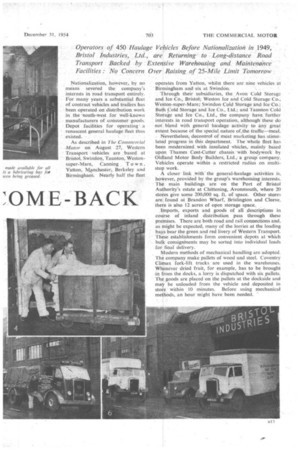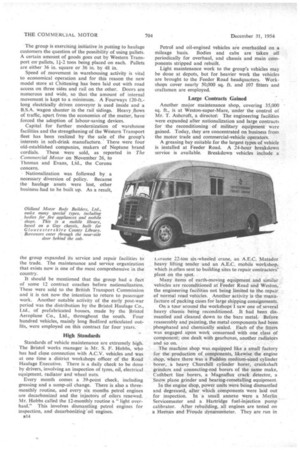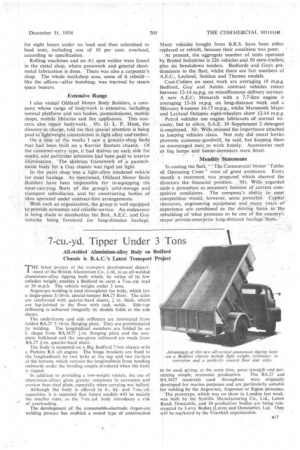STAGING A
Page 38

Page 39

Page 40

Page 43

If you've noticed an error in this article please click here to report it so we can fix it.
10ME-BACK . Operators of 450. Haulage Vehides Before Nationalization in 1949, Bristol Industries, Ltd., are Returning to Long-distance Road Transport Backed by : Extensive Warehousing and Maintenance Facilities : No Concern. Over Raising of 25-MileLimit Tomorrow .
NOVEMBER 17, 1949, was a black day for the directors of Bristol Industries, Ltd. Seven of their road transport subsidiaries passed to British Road Services, and on the cab doors of 450 vehicles the lionand-wheel badge became superimposed' upon such names as Bristol Haulage, Pioneer Transport, Henry Russett and Sons and L. H. Dimond.
• To men with haulage experience dating back to 1919, when Bristol Industries launched into road transport, the 1953 Act provided the heartening Opportunity to return to the industry which was in their blood. Western Transport, Ltd., was founded and 70 B.R.S. vehicles were purchased. A start was made this year on reforming the substantial transport organization that was appropriated five years ago.
Certainly the company have the resources to build up again rapidly, although, naturally, caution is being employed in these early stages. Their workshops can undertake vehicle maintenance including precision machining and specialized reconditioning of components; some 500,000 sq. ft. of warehousing space is owned; a bodybuilding subsidiary can construct and repair bodywOrk of all descriptions; but, most imPortant of all, many customercontacts have been preserved and re-eStablished.
Many traders liked to support free enterprise and the goodwill, using the Word in its broadest . sense, that the company had in 1949 had not been . dissipated by the mere process of State acquisition of so Many of their vehicles, Mr. A. F. Wills, vice-chairmani of Bristol Industries, told me. Conditions regarding the availability of traffic were favourable and improving.
Mr. Wills does not fear the lifting of the 25-Mile limit tomorrow. " Large numbers of hauliers with A licences restricted themselves to local and medium-distancz work before nationalization," he explained: "It suited them to do so and they ran only the occasional long journey. If, after January 1, short-distance hauliers were to turn to trunk work; 'someone .else would have to undertake the local serviees they would relinquish. We haven't done much short-.distance work since corning hack, but we have great past experience of it," he said
1312
Nationalization, however, by no means severed the company's interests in road transport entirely. For many years a substantial fleet of contract vehicles and trailers has been operated on distribution work in the 'south-west for well-known manufacturers of consumer. goods. Depot facilities for operating a renascent general haulage fleet thus ex isted As described in The Commercial -Motor on August 27, Western Transport vehicles are based at Bristol, Swindon, Taunton, Westonsuper-Mare, Canning Town, Yatton, IV4nchester, Berkeley and Birmingham. Nearly half the fleet
operates from Yatton, whilst there arc nine vehicles at Birmingham and six at SwindOn.
. Through their subsidiaries, the Avon Cold Storage and Ice Co., Bristol; Weston Ice and cold Storage Co., Weston-super-Mare; Swindon Cold Storage and-Ice Co.!;. Bath Cold Storage and Ice Co., Ltd.; and Taunton" Cold Storage and fee 'Co., Ltd., the company have further interests in road transport operation, although' these do not blend with general haulage activity to án Y greatextent because of the special nature of,the traffic—Meai. . Nevertheless, decontrol of meat marketing has stimulated progress in this department. The whole fleet has been modernized with insulated .vhicles,. mainly based upon Thames Cost-Cutter chassis: with bodywork by Oldland Motor Body .BuilderS,.Ltd.; a group. company. Vehicles operate within a restricted radius on multistop work.
A closer link with the general-haulage activities is, however, provided by the group's warehousing interests. The main buildings are • on the Port of Bristol Authority's estate at Chittening, Avonmouth, where 20 stores give some 200,000 sq. ft. of space. Other stores are found at Brandon Wharf, Brislington and Cleeve, there is also 12 acres of open storage space..
Imports, exports and goods of all descriptions in course of inland distribution, pass through these premises. There arc both road and rail connections and, as might be expected, many of the-lorries at the loading .bays bear the green and red livery of Western Transport. These establishments form convenient depots at which bulk consignments may be sorted into individual loads for final delivery.
Modern methods of mechanical handling are adopted. The company make pallets of wood and steel. -Coventry Climax fork-lift trucks are used in the warehouses. Whenever dried fruit, for example, has to be brought -in from the docks, a lorry is dispatched with six pallets. The goods are placed on the pallets at the dOckside and may be unloaded. from the vehicle and deposited in store within '10 minutes. Before . using mechanical methods, an hour might have been needed. The group is exercising initiative in putting to haulage customers the question of the possibility of using pallets. A certain amount of goods goes out by Western Transport onpallets, 1 i-2 tons being placed on each. Pallets are either 36 in. square or 36 in. by 48 in.
Speed of movement in warehousing activity is vital to economical operation and for this reason the new model store at Chittening has been laid out with road access on three sides and rail on the other. Doors are numerous and wide, so that the amount of internal movement is kept to a minimum. A Fourways l40-ft.long electrically driven conveyor is used inside and a B.S.A. wagon shunter in the rail sidings. Heavy flows of traffic, apart from the economics of the matter, have forced the adoption of labour-saving devices.
Capital for further modernization of warehouse facilities and the strengthening of the Western Transport fleet has been realized by the sale of the group's interests in soft-drink manufacture. There were four old-established companies, makers of Neptune brand cordials. These were sold, as reported in The Commercial Motor on Sovember 26, to Thomas and Evans, Ltd., the Corona concern.
Nationalization was followed by a necessary diversion of policy. Because the haulage assets were lost, other business-had to be built up. As a result, the group expanded its service and repair facilities to the trade. The maintenance and service organization that exists now is one of the most comprehensive in.the country.
It should be mentioned that the group had a fleet of some 12 contract coaches before nationalization. These were sold to the British Transport Commission and it is not now the intention to return to passenger work. Another notable activity of the early post-war period was the distribution by the Bristol Haulage Co., Ltd., of prefabricated houses, made by the Bristol Aeroplane Co., Ltd., throughout the south. Four hundred vehicles, mainly long Bedford articulated outfits, were employed on this contract for four years.
High Standards
Standards of vehicle maintenance are extremely high. The Bristol works manager is Mr. S. F. Hobbs, who has had close connection with A.C.V. vehicles and was at one time a district workshops officer of the Road Haulage Executive. There is a daily check to be done by drivers, involving an inspection of tyres, oil, electrical equipment, radiator and wheel nuts.
Every month comes a 39-point check, including greasing and a sump-oil change. There is also a threemonthly routine, and every six months petrol engines are decarbonized and the injectors of oilers renewed. Mr. Hobbs called the I2-monthly routine a "light overhaul." This involves dismantling petrol engines for inspection, and decarbonizing oil engines.
B14 Petrol and oil-engined vehicles are overhauled on a mileage basis. Bodies and cabs are taken off periodically for overhaul, and chassis and main components stripped and rebuilt.
Light maintenance work to the group's vehicles may be done at depots, but for heavier work the vehicles are brought to the Feeder Road headquarters. Workshops cover nearly 50,000 sq. ft. and 107 fitters and craftsmen are employed.
Large Contracts Gained
Another major maintenance shop, covering 35,000 sq. ft., is at Weston-super-Mare, under the control of Mr. T. Ashcroft, a director. The engineering facilities were expanded after nationalization and large contracts for the reconditioning of military equipment wzre gained. Today, they are concentrated on business from the motor trade and commercial-vehicle operators.
A greasing bay suitable for the largest types of vehicle is installed at Feeder Road. A 24-hour breakdown service is available. Breakdown vehicles include a Loraine 22-ton six-wheeled crane, an A.E.C. Matador heavy lifting tender and an A.E.C. mobile workshop, which is often sent to building sites to repair contractors' plant on the spot.
Many items of earth-moving equipment and similar vehicles are reconditioned at Feeder Road and Weston, the engineering facilities not being limited to the repair of normal road vehicles. Another activity is the manufacture of packing cases for large shipping consignments.
On a tour around the workshops I saw one of several heavy chassis being reconditioned. It had been dismantled and cleaned down to the bare metal. Before reassembly and painting, the metal components had been phosphated and chemically sealed. Each of the fitters was engaged upon work concerned with one class of component; one dealt with gearboxes, another radiators and so on.
The machine shop was equipped like a small factory for the production of components, likewise the engine shop, where there was a Paddon medium-sized cylinder borer, a heavy Churchill cylinder borer, crankshaft grinders and connecting-rod borers of the same make, Cuthbert line borers, a Magnaflux crack detector, a Snow plane grinder and bearing-remetalling equipment.
In the engine shop, power units were being dismantled and degreased, after which components were laid out for inspection. In a small annexe were a Merlin Servicemaster and a Hartridge fuel-injection pump calibrator. After rebuilding, all engines are tested on a Heenan and Fronde dynamonieter. They are run in for eight hours under no load and then submitted to load tests, including one of 10 per cent. overload, according to specification.
Rolling machines and an Al„ spot welder were found in the metal shop, where presswork and general sheetmetal fabrication is done. There was also a carpenter's shop. The whole workshop area, some of it rebuilt— like the offices—after .boinbing, was warmed by steam space heaters.
Extensive Range I also visited Oldland Motor. Body Builders, a company whose range of bodywork is extensive, including normal platform and van bodies, pantechnicons, mobile shops, mobile libraries and fire appliances. This -concern also repair bodYWork. Mr. G. L. F, Hunt „ the director in charge, told the that special attention is being paid to lightweightconstruction in light alloy and timber. On a tour of the works "I saw a grocery-shop body that had been built on a Karrier: Bantam chassis. Of the customer entry type, it tad shelves on each side for stocks, and particular attention had been paid to interior illumination. The skeleton framework of ,a pantechnidon body for a Guy chassis was rigidyet light.
In the paint, shop was a light alloyinsulated vehicle for meat haulage. As mentioned, Oldia.nd Motor Body Builders' , have been responsible for re equipping the meat carrying fleets of the group's cold storage and transport subsidiaries, and for constructing bodies of Vans operated under contract-hire arrangements.
With such an organization, the group is well equipped 'to provide ecOnomic and reliable serVice. An endeavinir is being glade to standardize the fleet, Aac and Guy vehicles being. " favoured for long-distance haulage. Many vehicles bought from B.R.S. have been either replaced or rebuilt, because their condition was poor.
At present, the aggregate number of units operated by Bristol Industries is 226 vehicles and 50 semi trailers plus six breakdown tenders. Bedfords and Guys predominate in the fleet, whilst there are fair numbers of A.E.C., Leyland, Seddon and Thames models.
Cost-Cutters on meat work are averaging 18 m.p.g. Bedford, Guy and Austin contract vehicles return between 12-14 m.p.g. on miscellaneous delivery services. A new A.E.C. Monarch with a 7.7-litre engine is averaging 15-16 m.p.g. on long-distance work and a Mercury 8-tonner 16-17 m.p.g., whilst Mammoth Major and Leyland Octopus eight-wheelers show 12-14 m.p.g.
Petrol vehicles use engine lubricants of normal viscosity, but in oilers, S.A.E..10 Supplement 2 detergent is employed. Mr. Wills stressed the importance attached to keeping vehicles clean. Not only did smart lorries promote customer-goodwill, he said, but keeping them so encouraged men to work keenly. Accessories such as fog lamps and heater demisterswere fitted. . .
Monthly Statements In costing the fleet," The Commercial Motor ' Tables of Operating Costs" Were of great assistance. Every month a statement was prepared which showed the directors the -financial position. Mr. Wills regarded such 'a procedure" as necessary because of current competitive conditions. The company's ability to meet • competition Would, however, seem powerful. Capital resources, engineering equipMent and n-tany years of experience are combined as the driving foree, in-the rebuilding of what promises to be one of the .country's major private-enterprise long-distance haulage "fleets,












































































